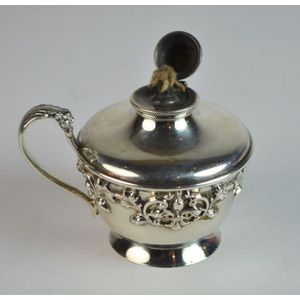Victorian Silver Covered Vegetable Dish
A Victorian silver covered vegetable dish, maker possibly William Cumming, London 1847, retailed by Harvey & Co., Regent Street, London, of circular form, the cover domed to centre wiith turned knop finial, gadrooned border, the interior with plain inner liner, entwined leaf capped scroll handles, the terminals amidst foliate clusters, 916 gms, 23 cm diameter
You must be a subscriber, and be logged in to view price and dealer details.
Subscribe Now to view actual auction price for this item
When you subscribe, you have the option of setting the currency in which to display prices to $Au, $US, $NZ or Stg.
This item has been sold, and the description, image and price are for reference purposes only.
- Victorian Period - The Victorian period of furniture and decorative arts design covers the reign of Queen Victoria from 1837 to 1901. There was not one dominant style of furniture in the Victorian period. Designers used and modified many historical styles such as Gothic, Tudor, Elizabethan, English Rococo, Neoclassical and others, although use of some styles, such as English Rococo and Gothic tended to dominate the furniture manufacture of the period.
The Victorian period was preceded by the Regency and William IV periods, and followed by the Edwardian period, named for Edward VII (1841 ? 1910) who was King of the United Kingdom and the British Dominions and Emperor of India for the brief period from 1901 until his death in 1910. - Gadrooning - A series of lobes usually as a border. In furniture gadrooning is found as carved decoration around the edges of table tops in the Chippendale and Jacobean style furniture. Gadrooning is also found as decoration on the rims of silver and ceramics.
- Knop (silver) - A knop on a silver item is either a bulbous protrusion mid way along a stem, such as on a candlestick or at the end of a stem, such as on a spoon, or a knob or finial on top of a cover or lid, that acts as a handle. On a stemmed item such as a candlestick there may be a series of knops of different shapes.
- Foliate - Decorated with leaves or leaf-like forms.
- Finial - An architectural decoration, found on the upper parts of of an object. On furniture they are usually found on pediments, canopies and shelf supports. On smaller ceramic or silver items, such as spoons, they may decorate the top of the item itself, or the lid or cover where they provide a useful handle for removal.
Finials have a variety of shapes and forms. They may be urn-shaped, baluster shaped round or spiral, but usually taper into an upper point. Many real life shapes may also be used as finials, such as pineapples, berries, pinecones, buds, lotus and acorns. Sometimes animals such as a lion are depicted, or fish and dolphins.
This item has been included into following indexes:
- dishes
Visually similar items

George III sterling silver mustard pot, hallmarked London 1805 (John Emes), with glass liner, 10 cm wide, 106 grams (silver content)
Sold by
in
for
You can display prices in $Au, $US, $NZ or Stg.

Chinese blue and white lidded jar, decorated with scrolling leaves and flowers, the lid surmounted with a frog, height 22 cm
Sold by
in
for
You can display prices in $Au, $US, $NZ or Stg.

Sold by
in
for
You can display prices in $Au, $US, $NZ or Stg.

An American sterling silver cigar table lighter early 20th century by Jaccard jewellery Co, USA, height: 6.8 cm, diameter 5.5 cm
Sold by
in
for
You can display prices in $Au, $US, $NZ or Stg.
